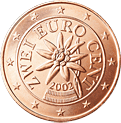Austrian euro design
Prior to 2008, the old common side showing national borders was used, but from the 2008 coins use the new common side without borders. For images of the common side and a detailed description of the coins, see euro coins. Austria is the only country which uses the Latin alphabet and yet, repeats the denomination on the national side of the coins, thus not adhering to the rule.
From 2017 (5 cent coins) and 2018 (2 and 1 cent coins) onwards, the design of the national side has been slightly altered, decreasing the thickness and increasing the amount of hatching representing the red fields of the Austrian flag. [1] [2] [3]
| € 0.01 | € 0.02 | € 0.05 |
|---|---|---|
 |  |  |
| An Alpine gentian as a symbol of Austria's part in developing EU environmental policy. | An Alpine edelweiss as a symbol of Austria's part in developing EU environmental policy. | An Alpine primrose as a symbol of Austria's part in developing EU environmental policy. |
| € 0.10 | € 0.20 | € 0.50 |
 |  |  |
| St. Stephen's Cathedral, the epitome of Viennese Gothic architecture dating to 1160. | Belvedere Palace, an example of Baroque architecture, symbolizing national freedom and sovereignty. | Secession Building within a circle, symbolising the birth of Art Nouveau and a new age in the country. |
| € 1.00 | € 2.00 | € 2 Coin Edge |
 |  | |
| Wolfgang Amadeus Mozart (with his signature), a famous Austrian composer, in reference to the idea of Austria as a "land of music". | Bertha von Suttner, a radical Austrian pacifist and Nobel Peace Prize winner, as a symbol of Austria's efforts to support peace. |






